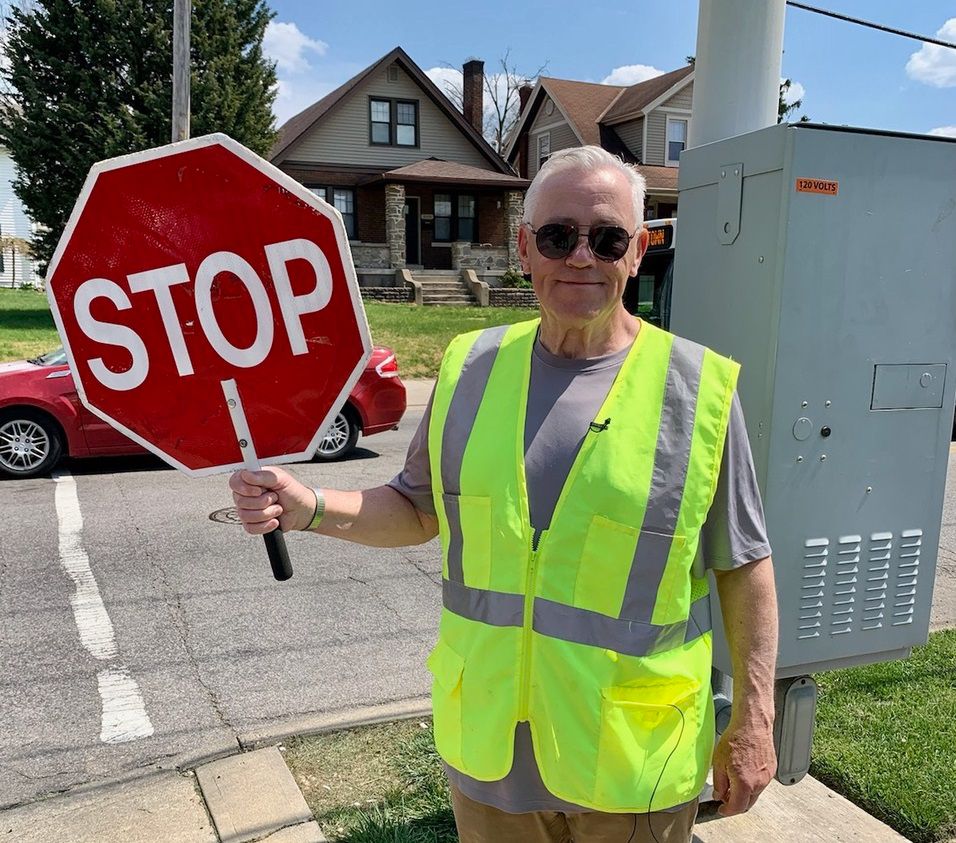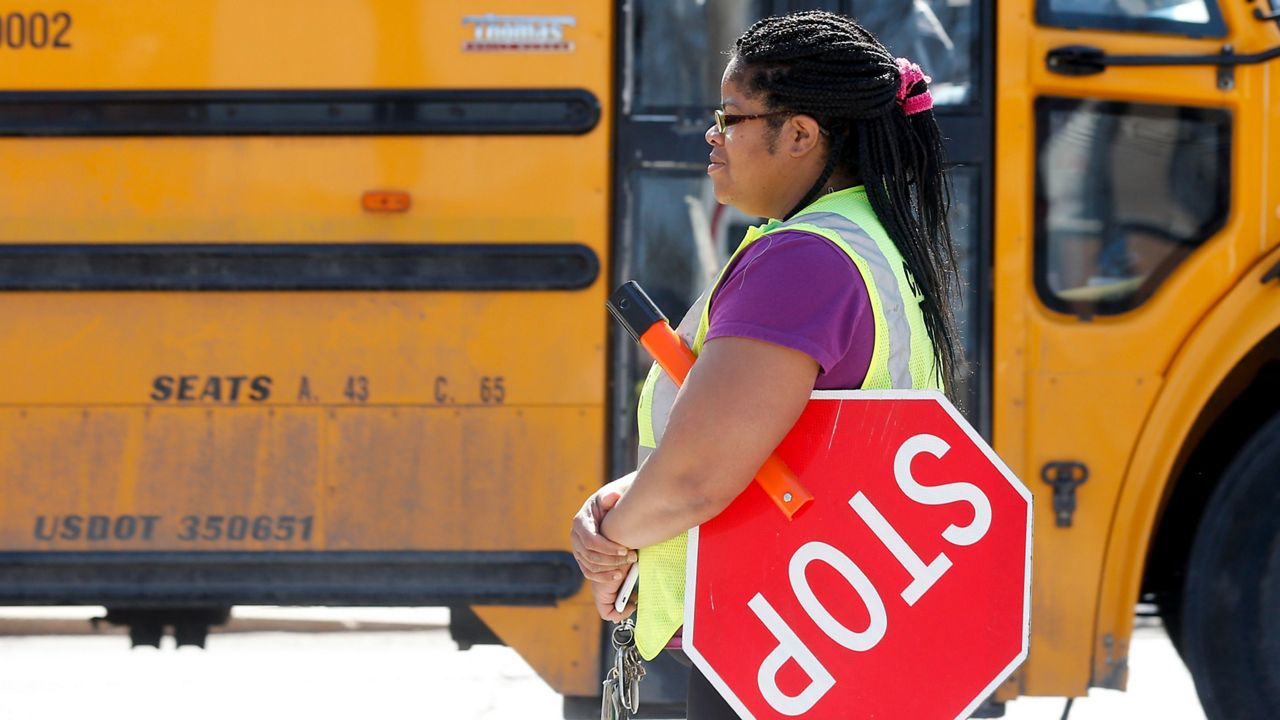CINCINNATI — With the start of Cincinnati Public Schools, parents across the city are worried whether anyone will be there to help their children safely cross the street.
What You Need To Know
- Cincinnati Public Schools is looking to fill another 40 crossing guard positions
- The district plans for more than 150 crossing guards across its 91-square-mile coverage area
- Parents and elected leaders see crossing guards as critical to public safety for students
- The Cincinnati Board of Education and the City of Cincinnati recently bumped crossing guard pay to $15 per hour
One of those parents is Brooke Lehenbauer.
Lehenbauer loves the crossing guard outside her children’s school at Parker Woods Montessori School. She described the guard as “friendly and helpful” to all the students and parents who parade to school along Langland Street, the major traffic intersection for getting in and out of the school in Cincinnati’s Northside neighborhood.
The problem for Lehenbauer is her family doesn’t use Langland Street to get to school. They go up Beech Hill Avenue, which doesn’t have a crossing guard.
“There’s definitely a lot of cars that go by without yielding, so you just kind of have to hang back and wait,” she said.
To address the concerns of parents like Lehenbauer, the City of Cincinnati and CPS have been working together to revamp the district’s crossing guard program.
Along with engagement and recruiting efforts, the Cincinnati Board of Education voted during summer break to increase the pay rate for crossing guards from $11 per hour to $15 per hour. The City of Cincinnati supported the pay hike as well.

CPS pays for the guards, but the city hires and trains them through the Cincinnati Police Department (CPD). The department also trains and hires crossing guards for some private and charter schools.
Mike Moroski, a member of the Cincinnati Board of Education, described crossing guards as “crucial to our operations as a large public school district.”
Lehenbauer would “love to have a crossing guard” for her children, especially as they get older and potentially walk to school by themselves. Her daughter Emery is entering the second grade and her son Simon is a preschooler.
The family lives too close to school to qualify for bus pickup. Lehenbauer also doesn’t want to get caught in the “Wild West”' that is the morning drop-off and pickup, she said.
It’s less than a mile to Parker Woods, but even in that 10 to 15-minute walk from Fergus Street to Beech Hill Avenue there are constant traffic challenges, especially speeding, Lehenbauer said.
Despite efforts by Mayor Aftab Pureval and City Council to enact policies and programs to reduce speeding in school areas and business districts across the city, collisions involving pedestrians continue to be a problem.
City data shows there’ve been 163 pedestrian-related traffic crashes so far this year. That number is actually slightly lower than the previous two years. But the number of severe crashes involving pedestrians (34) is just as high as last year and 13 more than 2020.
The need for more crossing guards is as pressing as ever, Pureval stressed. He thanked crossing guards for their "service and commitment to our communities."
"As students head back to school, it is another reminder that we must ensure our streets are safe for all Cincinnati families," Pureval added. "Having just increased the pay for crossing guards to attract more applicants, we recognize how critical this position is — protecting children’s lives every single day."
Over the last year, CPS added 20 positions to cover more of its 91-square-mile district. There are guards stationed at most elementary schools and eight of the district’s high schools.
Recruiting continues for Cincinnati crossing guards
Despite the importance of the position, staffing has been an issue for years.
There were 49 vacancies out of 135 crossing guard positions at the start of the last school year. While recruiting took place throughout the year, a mixture of resignations and other issues resulted in CPS still being short 44 guards by the last day of school, according to Angie Kloepfer, a CPD employee who oversees the crossing guard program.
As of Wednesday, there are 42 vacancies and 114 positions filled, Kloepfer said.
Moroski stated he hoped the pay increase would attract “more than enough” crossing guards to begin this year. And so far it seems to be working.
Kloepfer has run the crossing guard program for a year-and-a-half. She credited the “proactive measures” of the leaders at City Hall and Cincinnati Public Schools for deciding to bump the pay rate. She’s already seeing dividends.
“I’ve seen more applications to be crossing guards since the middle of June than all of last school year,” she added.

Kloepfer said the plan is to use a combination of school security officers and CPD school resources officers, when available, to help offset the number of vacancies.
She promised someone would be at “all major intersections” near schools to help kids safely cross the street.
“We’re going to enlist the help of other entities to ensure children can cross safely,” Kloepfer said, noting that CPD continues to recruit additional crossing guards.
Before they hit the streets, crossing guards in Cincinnati receive two to four hours of training depending on their background, Kloepfer said. They go over a manual focused on specific traffic laws and best practices.
The training also provides tips for how to identify and deal with specific on-job situations, such as dealing with distracted drivers or “unruly pedestrians,” Kloepfer said.
There are two crossing guard shifts every school day — one begins 45 minutes before the start of the school day, and the other begins when school dismisses and lasts for 30 minutes. Those who work both shifts get paid for three hours a day, while those who work one shift get paid for 90 minutes of work.
Michelle D’Cruz has seen the benefits of the crossing guards firsthand.
She cherishes her morning walks to school with her children, Isa, 9, and Santi, 6. The family spends the three-block walk to North Avondale Montessori “singing songs, goofing off and talking about the day ahead.”
D’Cruz credited the crossing guard near her school with not only being a friendly face every morning but also for helping them get across the street safely. Getting across a “very busy” Clinton Springs Drive can be dangerous, especially when trying to be mindful of two young kids, she said.
“He’s diligent and firm with drivers, yet full of kindness for every child who walks his way,” D’Cruz added. “It amazes me that even amidst the heat, rain and snow, he finds the energy to connect individually with my kids, each and every day.”
Are you Cincinnati's next crossing guard?
This year’s group of crossing guards is a wide-range, Kloepfer said. She mentioned a handful of recent high school or college grads who haven’t been able to find full-time jobs. Many of the crossing guards are retirees or older adults who need extra income.
It’s also a great opportunity for adults with “high-functioning disabilities,” Kloepfer said.
“This is a great opportunity for anyone who has some free time and wants to give back to their community,” she added. “This is really meaningful work that I know our students, parents and teachers really appreciate and value.”
To be considered for a crossing guard position, a person needs to be at least 18 years old and feel comfortable working in any weather, Kloepfer said.
Applicants also need to pass a criminal background check. An applicant can’t have any felonies, violence-related misdemeanors or any crimes involving children in their background, Kloepfer said.
Recruiting for crossing guards is ongoing throughout the year. Those interested can pick up an application at any of the five CPD police districts or by emailing Kloepfer.
“This isn’t the first year that we’ve had to hire more crossing guards, but we’re hopeful with these pay increases, it will be the last we have this number of vacancies,” Kloepfer said. “My goal is to make sure we don’t have to fill these positions again next year.”



